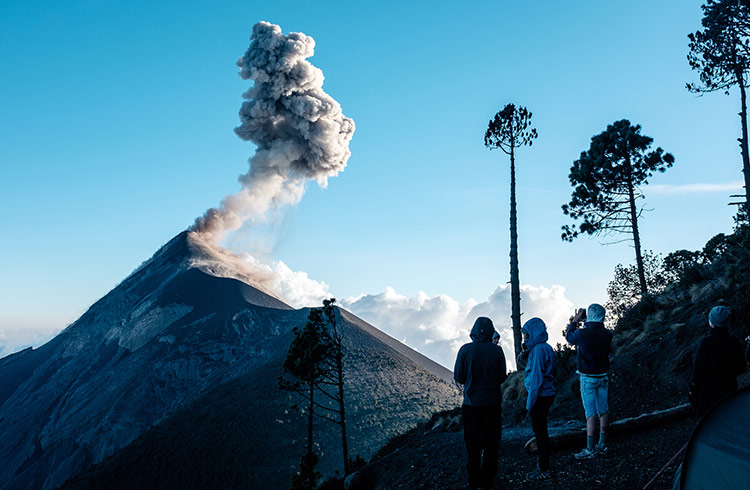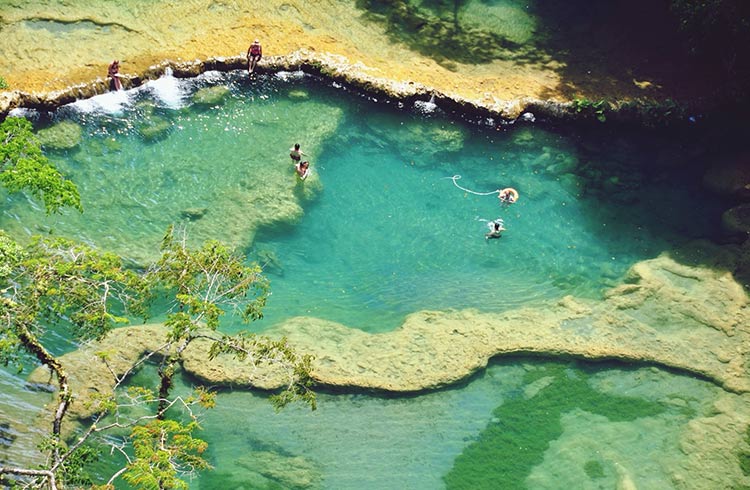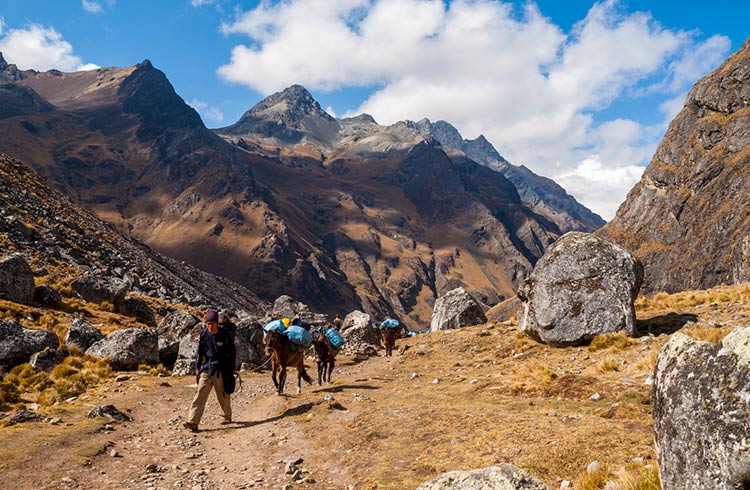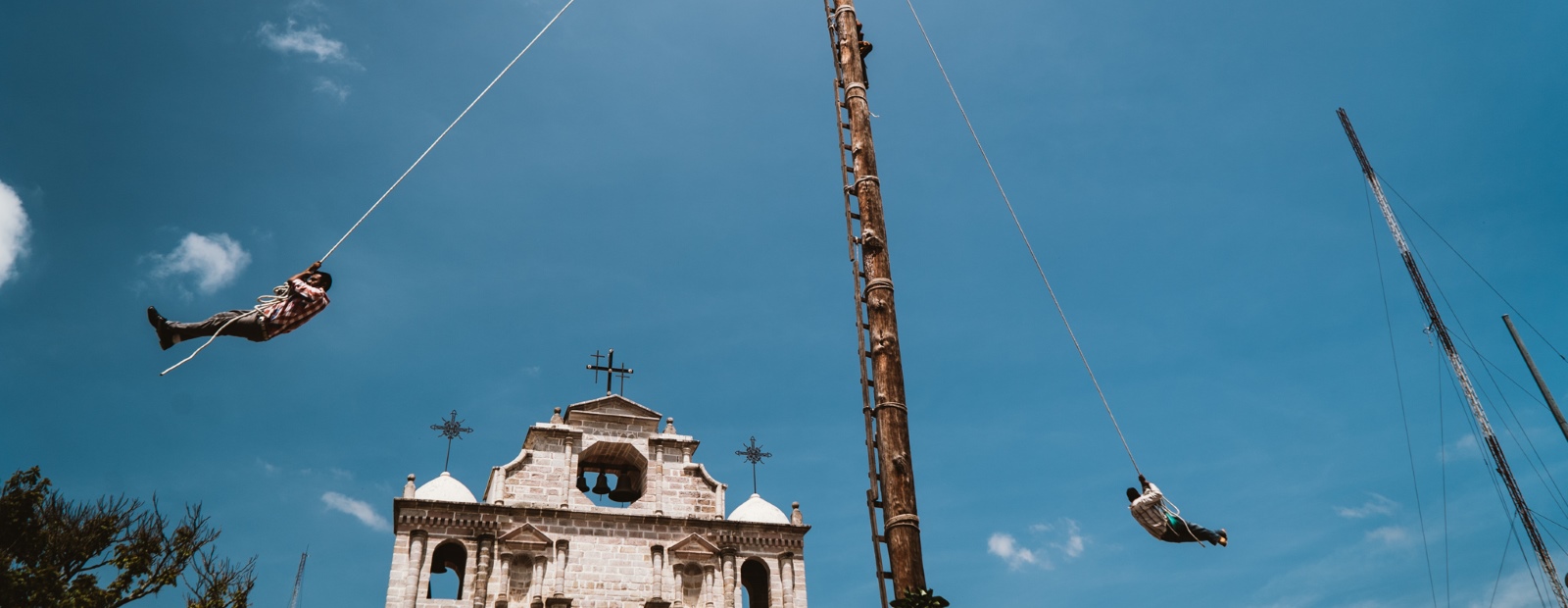8 Destinations for an Epic Adventure in Guatemala
Volcano hikes, ziplining, wild swimming, surfing, kayaking, wildlife spotting – the options for outdoor activities in Guatemala are limitless. Here are our favorite Guatemala adventures.
 Photo © Getty Images/Claudia Moser/EyeEm
Photo © Getty Images/Claudia Moser/EyeEm
Guatemala is as famous for its natural beauty as it is for its historic sites. With diverse landscapes ranging from cloud forests to black sand beaches and limestone caves, you'll find an abundance of outdoor adventures, including trekking, zip lining, kayaking, wild swimming, and even camping on volcanoes. These are some of the best adventures in Guatemala.
- Lago de Atitlan
- Climb Guatemala’s Volcanoes
- Rio Dulce and Lake El Golfete
- El Paredón on the Pacific Coast
- Semuc Champey
- Cuevas de Candelaria
- Laguna Lachua National Park
- Fuentes Georginas
Adventure in Lago de Atitlan
A few hours’
Lake Atitlan is a great spot for adventure. There is kayaking, scuba diving, hiking, zip lining, mountain biking, and even wildlife spotting at the Reserva Natural Atitlan. Accommodation wise, there are a few villages to choose from. Panajachel is the most built up, with plenty of ferries to the other villages, and transport links to the rest of the country. San Pedro is a hub for backpackers, known for its parties and Spanish schools, and San Marcos is a more laidback, spiritual Mecca.
For those seeking an authentic local experience, alternatives include Santa Cruz, which is known for hiking trails and good swimming spots, and Santiago, a local village famous for its worship of the Mayan God, Maximón. Wherever you choose to stay, Santiago’s vibrant markets, boatbuilding industry, and thriving local arts scene make it a great day trip from any of the other villages.
Hike to the top of a volcano
Guatemala has more than 37 volcanoes, and several of these are possible to climb. The most popular are Pacaya, close to Guatemala City, San Pedro in Lake Atitlan, and Acatenango, close to Antigua. If you’re looking for a real adventure, join a tour on an overnight hike to the top of Acatenango (13,044ft/3,976m above sea level). At night, you’ll be camping above the clouds on the slopes of the volcano, while watching the neighboring volcano, Fuego, erupt fiery lava against the midnight sky. At sunrise, you can summit for incredible views over Guatemala before heading back to Antigua for a well-deserved Mayan hot chocolate in one of many cafes.
If you’re not ready for the challenge of hiking to the top of Acatenango, nearby Pacaya (8,372ft/2,552m above sea level) has volcanic rocks and vents so hot you can roast marshmallows. Pacaya is one of Central America’s most active volcanoes and one of only three active volcanoes in Guatemala.
Don’t attempt to hike the volcanoes without a local guide. Guides are relatively inexpensive, will help guard you against would-be-thieves, and ensure your safety at high elevations – especially when staying overnight or visiting active volcanoes like Pacaya. Guides can be organized in Antigua, Guatemala City, or Lake Atitlan.

Wildlife of the Rio Dulce and Lake El Golfete
The spectacular emerald green waters, waterfalls, jungle and wildlife of the Rio Dulce and Lake El Golfete are becoming increasingly popular among travelers to Guatemala. Take a boat trip up the river and through the gorge to see howler monkeys, toucans, and wildflowers peeking through the dense jungle. Go sailing, trek through the forest, and swim in the Finca Paraiso Hot Springs Waterfall.
For a bit of history and culture, visit the Mayan ruins at Quiriguá, home to some of Guatemala’s most impressive Mayan statues, and the 17th-century Castillo de San Felipe Fort in the Rio Dulce National Park.
There are plenty of accommodation options available, including remote jungle lodges that can only be accessed by boat. Shuttles from Rio Dulce run to most places in Guatemala and Honduras, and you can also travel by lancha (small local ferries) onto Livingston on the Caribbean coast and connect to Punta Gorda in Belize.

Black sand beaches of El Paredón on the Pacific Coast
On the other side of Guatemala, a few hours drive from Antigua and Guatemala City through the steamy Pacific Highlands lies the beautiful black sand beaches of Guatemala’s Pacific coastline. Famous for its sea-turtle nesting sites, amazing surf breaks, and boat trips through the tropical mangroves, the Pacific coast has become a popular getaway for those needing to escape the hustle of the cities and relax.
Our favorite beach was El Paredón in Sipacate-El Naranjo National Park, which is close to the border with El Salvador. This small fishing village is the perfect place to escape the weekend crowds of Monterrico, ride horses along the volcanic sand, and see diverse birds and migratory whales that call this place home.
Wild-swimming in Semuc Champey
With its turquoise pools and cascading falls, Semuc Champey in the jungle is one of Guatemala’s most popular natural wonders. Here you can explore limestone cave systems, go wild-swimming, river tubing, take a 30-minute hike up to the mirador (viewpoint), or simply grab a coffee and relax in a hammock at the laid-back village.
As Semuc Champey’s main hotspot is possible to visit in a day trip, many travelers choose to stay in the nearby village of Lanquin, just 6mi (10km) away, but there are also a handful of accommodation options close to the park. Shuttle transport is available between the major tourist hotspots.

Floating through Cuevas de Candelaria
Guatemala’s mountains are honeycombed with limestone caverns, and none more so than Alta Verapaz, home to the incredible Candelaria caves. These caves feature a series of caverns and passages that have been eroded by the Rio Candelaria over millennia.
The best way to explore the caverns and see the stalactites is by floating along the river in an inner tube, occasionally breaking out of the caves into bright sunlight and tropical jungle before plunging back into the darkness.
North of Semuc Champey, the remote Candelaria Caves can be difficult to access by public transport, so most visitors hire a car or contact the local hotels to see if they can organize transfers. The hotels also organize tubing tours through the caves.
Explore Laguna Lachua National Park
Not far from Cuevas de Candelaria, the beautiful Laguna Lachua National Park is well worth discovering. This tranquil national park is pretty off-the-beaten-track, so you will need to organize your own transport or to join a tour to get there, but those who brave the journey will be rewarded by a huge, uniquely circular lagoon surrounded by tropical jungle which is home to tapirs, wild cats, howler monkeys, armadillos, and some of Central America’s most beautiful birds.
This is no doubt one of Guatemala’s best swimming spots – on a clear day, you can see almost to the bottom of the lake, which is 656ft (200m) beneath the surface.
Natural hot springs at Fuentes Georginas
Chill for the afternoon at Fuentes Georginas, a natural hot spring on the side of a volcano, surrounded by tropical jungle, ferns, orchids, and hummingbirds.
Located close to Quetzaltenango, you can join a tour or take a chicken bus to Zunil and then hitch a ride to the springs. Accommodation available on-site is in basic, rustic cabins, and guests have access to the hot spring pools at night.
From here, you can also hike to Volcán Zunil or Volcán Santo Tomas, although it is essential to take a guide with you for safety. Guides can be organized inside the local restaurant.
Related articles
Simple and flexible travel insurance
You can buy at home or while traveling, and claim online from anywhere in the world. With 150+ adventure activities covered and 24/7 emergency assistance.
Get a quote


1 Comment
Surprised that Tikal didn't make the list. The ruins and wildlife are terrific. The birding at day's end at Mundo Perdido is extraordinary. Guatemala is a terrific destination, but a little unsettling that when hiking the volcanos it's not safe without a guide.